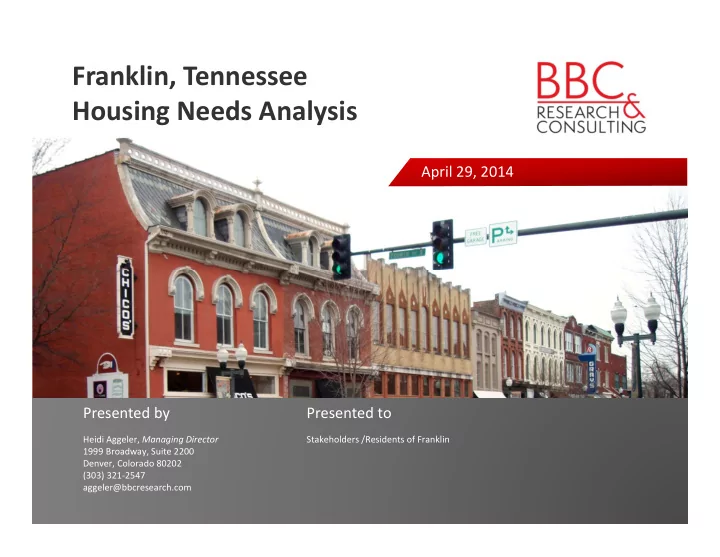

Franklin, Tennessee Housing Needs Analysis April 29, 2014 Presented by Presented to Heidi Aggeler, Managing Director Stakeholders /Residents of Franklin 1999 Broadway, Suite 2200 Denver, Colorado 80202 (303) 321-2547 aggeler@bbcresearch.com
Purpose of Housing Study “To assist decision makers, stakeholders, and citizens with understanding key housing issues; provide a measured assessment of present and future unmet housing demand; offer community leaders and stakeholders a basis for formulating specific housing priorities, policy alternatives, and related strategies .” 2
What does the Housing Study involve? ● Community profile ● Housing profile ● Housing gaps analysis ● Public and stakeholder input ► Focus groups (January 2014) ► Public meetings (January 2014, now) ► Resident survey (789 responses) ► In-commuter survey (244 responses) ● Recommendations of strategies and actions for Housing Plan 3
Agenda for Today ● Who is Franklin today? ● What are Franklin’s current housing gaps? ● Where will Franklin be tomorrow? ● What type of housing growth do residents prefer? ● Recommended strategies to meet needs ● Discussion 4
2000-2012 Trends ● Population in 2012 = 66,278 ● Gained 10,000 residents age 45-64 (50% of new growth) ● Proportion of 25-44 year olds declined (working population) ● Proportion of families with children declined, 39% to 33% ● No change in poverty ( 7% ). Children have highest poverty rate ● 2010-2035 growth will be strongest for seniors (5.6% increase/year) and weakest for children (1.1% increase/year) 5
Housing Gaps ● What does a renter need to make to afford median gross rent? $42,000/year. 60% of Franklin renters earn enough ● Some renters struggle to live in Franklin. 1,300 renters earn < $25,000 and can’t afford their rent ● Homeownership in Franklin lower ( 65% ) than in county (79%) and state (67%). ● Homeownership challenging for 50% of renters. Only 9% of homes to choose from. 6
Commuting, 2012 Franklin businesses employ 51,000 workers ● 43,000 commute in to Franklin (85% of workers) ● 7,800 live and work in Franklin ● = 85% of jobs are held by in-commuters 17,500 work outside Franklin but live in Franklin 7
Commuting, 2012 Why don’t in-commuters live in Franklin? (75% would if they could) “Couldn’t find an affordable single family home to buy” “Franklin is out of my price range” “Housing I could afford was in lower quality/needed improvements” “Housing I could afford in Franklin was too small” 8
Commuting, 2025 16,000 new workers by 2025 Where will they live? If in-commuting ratio stays the same = 14,000 more in-commuters 9
Future growth: What do people want? They want Franklin to preserve: ● Character and charm ● Historic preservation/downtown ● Community character and social diversity ● High quality schools They want Franklin to change: ● Traffic congestion (less) ● Housing affordability (more) ● Parks/open space and walk- and bike-ability (more) ● Housing product diversity utilizing high quality design (important) 10
Future growth: What do people want? More affordable housing: ● Homes priced below $250,000 ● Smaller single family detached homes ● Homes priced below $350,000 11
Recommended Strategies Start with what the city has done well and make it better: ● Strengthen inclusionary zoning ordinance ● Develop more dense, mixed-income communities (ala West Haven) ● Take advantage of existing infrastructure (infill, revitalization) 12
Inclusionary Zoning What is it? Requires developers of residential housing to make a certain percentage of units affordable at various price points Many types of IZ: ● Voluntary (Franklin) ● Mandatory (most ordinances) ● Homeownership only (Colorado communities) ● Homeownership and rental Percentage requirement is generally between 10% and 20% of units developed 13
Inclusionary Zoning ● Units can be required to be on-site, off-site (Denver), or some combination (Boulder, must be at least 50%) ● Cash-in-lieu fee option (should reflect difference in affordable and market rate unit, Chapel Hill) ● IZ units have a deed-restriction, or covenant, attached to their deed that limits appreciation (avoids windfall for buyer) ● Cities often provide bonuses to developers to offset costs of IZ (fee waivers, meaningful density bonuses, lower parking requirements) ● Some target special needs (Arvada, Austin visitabilty ordinances) ● First right of refusal for cities in event of foreclosure ● Some ordinances give preferences to workforce (CO mountains) 14
Inclusionary Zoning How can Franklin’s ordinance be strengthened? ● Make mandatory ● Raise the cash in lieu fee ● Make density bonuses meaningful (may involve strengthening existing code. Chapel Hill good example) ● Use fast track approvals ● Preserve option to rehabilitate existing units and land donation ● Consider building in workforce preferences ● Consider a visitability component 15
Recommended Strategies Beyond inclusionary zoning: ● Establish a vision and goals for percentage of units affordable to workforce. This will empower BOMA and planning staff ● Review city zoning ordinance for allowance and facilitation of: � Mixed-income, mixed-density housing � ADUs and cottage homes � Transparency in development approvals � Residential infill development incentives ● Offer fee waivers and fast track approval for developments that incorporate affordable housing (sliding scale) ● Inventory vacant and underutilized land parcels for residential development potential. Develop a vision for redevelopment and check against zoning 16
Thank you for your attendance today! 17
Recommend
More recommend